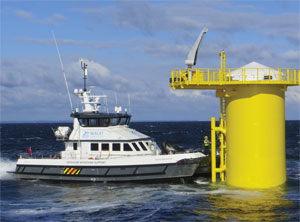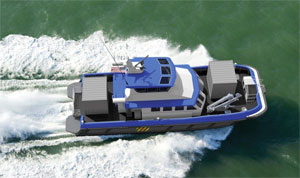In North America’s first maritime contracts for offshore wind service, Rhode Island Fast Ferry has clinched a long-term crew-transfer deal with Deepwater Wind, enabling it to commission the first U.S.-built offshore wind vessel.
At Warren, R.I.-based Blount Boats shipyard, workers have completed the bulkheads and are plating the vessel that will service the 30-MW Block Island Wind Farm now in pre-construction.
“A crew of 70 workers is building the hull and superstructure separately in our yard,” said Marcia Blount, president of Blount Boats. Construction of the vessel is at about 5 percent with completion scheduled for early April 2016, she said.
“The vessel will be U.S.-flagged and built under U.S. Coast Guard supervision,” Blount said.
Construction of the crew transfer vessel (CTV) was made possible by a deal announced on May 18 between Providence, R.I.-based Deepwater Wind and Rhode Island Fast Ferry, which was commissioned to build and operate the vessel. North Kingston, R.I.-based RIFF has invested $4 million to build and provide training for the Deepwater Wind Block Island Wind Farm.
The five-turbine Block Island Wind pilot project — on track to be the first offshore wind farm in the U.S. — is one of four offshore wind farms planning to sink steel into water off the coast of Rhode Island between Martha’s Vineyard and Block Island. The other three are Denmark-based Dong Energy; Offshore MW, the U.S. arm of the German company WindMW; and RES Americas, a subsidiary of a British conglomerate. “These could potentially require 500 to 600 wind turbines,” said Charles Donadio Jr., president of Rhode Island Fast Ferry.
RIFF’s subsidiary brand, Atlantic Wind Transfers, will provide crew and equipment support during construction of the Block Island Wind Farm beginning in spring 2016, Donadio said. Following completion of the site, work will move into operations and maintenance, with additional crew transfer support required throughout the project’s 20-year life cycle.
 |
|
Courtesy Seacat Services |
From its dockage facility at Quonset Point, RIFF is positioned to provide quick and convenient access to the Block Island Wind Farm site using the new CTV, Donadio said. “Our position is the most strategic for the entire region,” he said.
The CTV vessel was designed by South Boats IOW (Isle of Wight) England, a pioneer in designing and manufacturing crew transfer vessels, Blount said. The company has designed and built about 85 CTVs for the European offshore wind sector.
In 2011, Blount Boats signed a licensing agreement with South Boats to become the exclusive shipyard to manufacture U.S.-flagged aluminum catamarans of South Boats IOW designs for the U.S. wind farm industry, Blount said.
The 69-foot wind farm vessel is an all-aluminum catamaran that will be dual-certified to U.S. Coast Guard Subchapter T (small passenger) to carry up to 49 passengers and Subchapter L (offshore supply vessel) to carry up to 16 offshore workers, Blount said.
“Speed is important because the vessels drop two technicians at a time at a turbine then go to the next,” she said. “They are needed for technicians when building the wind farm and then for maintenance of the nacelles.”
The square bow of the vessel has a rubberized platform for boarding and unloading workers from the vessel to the wind turbine, Blount said. The vessel connects to the turbine base using a unique bow-fendering system that allows for making transfers in 5-foot waves, she added.
“The bow corner fenders are made by Ocean 3, a French company, with a polyethylene foam core with high abrasion resistance coating,” Blount said. “The center fender is made by RG Seasight-Fenders of Denmark from hot vulcanized rubber with grooves in cross pattern on the surface for better friction.”

